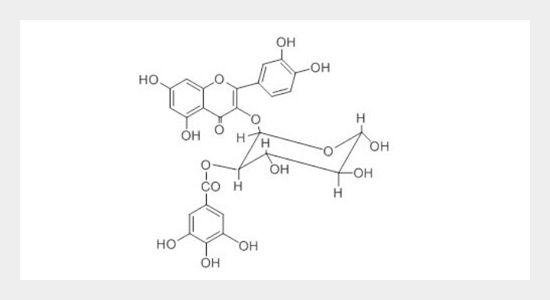R. Manivannan, K. Prabakaran*, and S. Ilayaraja Department of Chemistry, Government Arts College (Autonomous), Kumbakonam, Tamilnadu, India
Download Citation:
|
Download PDF
Flavonoids were isolated from flowers of Salvia leucantha using chromatography separation techniques. The structure of the isolated compound was analyzed by chemical tests and spectroscopic methods such as UV, 1H-NMR, and 13C-NMR. The spectral data’s proved its structure confirmed as Quercetin-3-O- α-L- rhamnopyranoside -2”- gallate. The present study was to evaluate the agar diffusion antibacterial against gram positive and gram negative microorganisms and wound healing activities to excision wound model in albino rats, respectively. The highest inhibitory zone was observed in S. aurous (28mm), and E. coli (24mm). The results revealed most valuable information and also support the continued sustainable use of Quercetin-3-O- α-L- rhamnopyranoside -2”- gallate isolated from Salvia leucantha in traditional system of medicine for future development of new antibiotic agents.ABSTRACT
Keywords:
Quercetin-3-O-α-L-Rhamnopyranoside -2" - gallate; antibacterial activity; Salvia leucantha; wound healing.
Share this article with your colleagues
[1] Manivannan, R. and Sukumar, D. 2007. The RBC memebrane stablisation in an in vitro method by the drug isolated from Leucas aspera. Internation Journal of Applied Science and Engineering, 5, 2: 133-138.REFERENCES
[2] MC Cutcheon, A. R., Ellis, S. M., Hancock, R. E. W., and Towers, G. H. N. 1992. Antibiotic screening of medicinal plants of the British Columbian native peoples. Journal of Ethnopharmcology, 37: 213-223.
[3] Shahidi, B. 2004. Evaluation of antibacterial properties of some medicinal plants used in Iran. Journal of Ethnopharmcology. 94: 301-305.
[4] Zaidan, M. R. S., Noor Rain, A., Badrul, A. R., Adlin, A., Norazah, A., and Zakiah, I. 2005. In vitro screening of five local medicinal plants for antibacterial activity using disc diffusion method. Trop Biomed, 22, 2: 165-170.
[5] Kelmanson, J. E., Jagar, A. K., and Van Staden, J. 2000. Zulu medicinal plants with antibacterial activity. Journal of Ethnopharmcology, 69: 241-246.
[6] Iwu, M. W., Duncan, A. R., and Okunji, C. O. 1999. “New Antimicrobials of Plant Orgin, In: Janick. J. (ed.): Perspectives on New Crops and New Uses”. ASHS Press, Alexandria, 457-462.
[7] Mari, M., Bertolini, P., and Pratella, G. C. 2003. Non-Conventional methods for the control of Post-Harvest pear diseases. Journal of Applied Microbiology, 94, 5: 761-766.
[8] Obagwu, J., and Korsten, L. 2003. Control of citrus green and blue molds with garlic extracts. European Journal of Plant Pathol, 109: 2-7.
[9] Ramzi, S. C., Vinay, K., and Stanley, R. 1994. Pathologic basis of diseases. Philadelphia: WB Saunders Company, 5: 86.
[10] Savanth, S. S. and Shah, R. 1998. “Text book and atlas of Dermatology and Cosmetology”. Mumbai: ASCAD, 12-17.
[11] Harborne, J. and Mabry, T. J. 1982. “The flavonoids Advances in Research”. Chapman and Hall, London.
[12] Abe, , Iwase, Y., Yamuchi, T., Yahara, S., and Nohara, T. 1995. Flavonol sinupoyl glycosides from leaves of Thevetia peruviana. Phytochem, 40: 577-581.
[13] Agarwal, K., and Bansal, M. C. 1989. Flavonoid glycoside. In: Agarwal, P. K. (ed.) “Carbon 13 NMR of flavonoid”. Elsevier, Amesterd, 283-364.
[14] Markharn, R., Ternai, B., Stanley, R., Geiger, H., and Mabry, T. J. 1978. Carbon 13 NMR studies of flavonoids-III, Naturally occurring flavonoid glycosides and their acylated derivatives. Tetrahed, 34: 1389-1397.
[15] Myers, A., Marshal, R. D., and Friedin, J. 1980. “Principles of pathology in surgery, 1st edn”. London, Blackwell Scientific Publications, 58-82.
[16] Manivannan, R. and Ilayaraja, S. 2013. Kaempferol-3-O-α -L-arabinopyranosyl (1→6)-β-D- galactopyranoside from Phytolacca octandra and its antimicrobial activity.Chemistry of Natural Compounds, 49: 336-337.
[17] Parul Lakhanpal, and Deepak Kumar Rai. 2007. Quercetin: a versatile flavonoid. Internet Journal of Medical Update, 2: 722-737.
ARTICLE INFORMATION
Received:
2013-06-18
Revised:
2014-02-05
Accepted:
2014-02-13
Available Online:
2014-06-01
Manivannan, R., Prabakaran, K., Ilayaraja, S. 2014. Isolation, Identification and antibacterial and wound healing studies of Quercetin-3-O-α-L- Rhamnopyranoside -2〞-Gallate. International Journal of Applied Science and Engineering, 12, 99–106. https://doi.org/10.6703/IJASE.2014.12(2).99
Cite this article:






